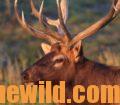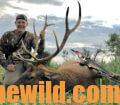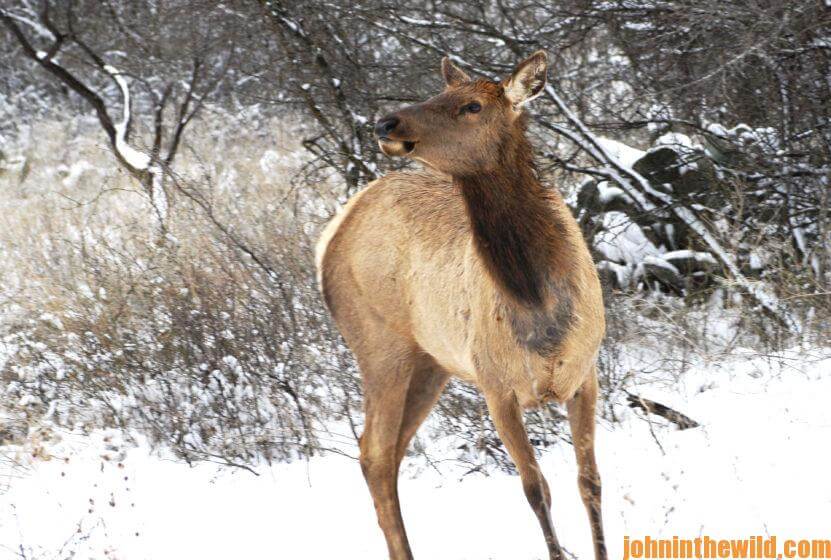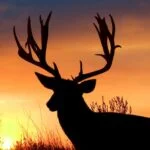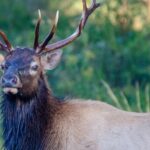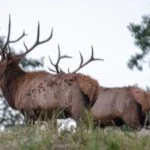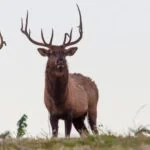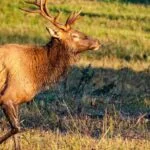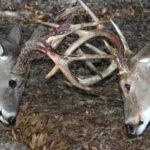Editor’s Note: “Because we harvest 45 – 50 elk every year, and I’ve been guiding elk hunters for 27 years, I’ve probably called in over 800 elk that have been taken at our outfitting company, Fulldraw Outfitters (www.fulldrawoutfitters.com),” Fred Eichler of Aguilar, Colorado, explains. To learn more about Eichler, go to his Facebook page at https://www.facebook.com/pg/fredeichlerpage/.
I’m constantly learning new things about elk hunting because I guide so much. I believe I get more experience and learn more from guiding elk hunters and not taking the shot, than most elk hunters learn in a lifetime. Even so, the elk teach me something new almost every day I hunt them. I also guide for turkeys, mule deer, ducks, antelope, and predators. When turkey decoys first came out, most of them looked terrible. But I think because the turkeys never had seen them before, the turkeys would come to them – even if they were ugly. Some of the decoys looked more like buzzards than turkeys. However, when you put that decoy out, those gobblers fell in love with those ugly decoys and would come running in to mate with them
Right now, elk haven’t been educated to decoys. I’ve had elk come in and knock-over my elk decoys. I’ve had them push them with their noses and antlers, however, like the turkey decoys, once the elk become accustomed to seeing decoys, we’ll have to start using more lifelike decoys than what we use now. I think at some time, elk will get educated about decoys. However, right now they’re not. The elk will come in and often run in to see the cow (decoy) that they’ve been heard talking to them. Elk, especially on public lands, usually will circle around someone’s calling before they come in for a shot. But with a decoy, their eyes confirm what their ears have heard, and they’ll usually come straight in to the decoy. So, I’ve started using an elk decoy often, since I’ve learned how effective a decoy can be, especially for a bowhunter. Right now, I’m using a Montana decoy (https://www.montanadecoy.com/), and I think my elk decoy definitely will help a hunter take more elk. That Montana decoy is super-light, pops-up and is easy to carry on my pack, because it folds-up. It probably doesn’t weigh 1 – 1-1/2 pounds.
* When Bull Elk Answer Cow Calls Every Time – On this particular hunt, I had a bull that would answer my cow calls every time I called to him. However, he wouldn’t close the distance to come in close enough for me to take the shot. I finally realized that the bull couldn’t see my decoy. The bull would come close and look for the cow, and because he couldn’t see her, he’d drop back. When he dropped back the last time, I made a move and put the decoy in a different place. Then the next time the bull elk came to take a look, he’d see what he thought was his sweetheart.
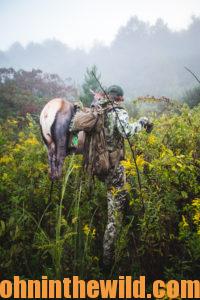 As soon as that bull elk spotted the decoy, his whole demeanor changed. He came walking straight to the decoy, and I shot him at 8 yards. I learned from that bull that elk react to decoys just like turkeys, ducks, deer and predators react to decoys, once he believed that the decoy was the critter that had been calling to him. Then he became totally convinced to go to that decoy.
As soon as that bull elk spotted the decoy, his whole demeanor changed. He came walking straight to the decoy, and I shot him at 8 yards. I learned from that bull that elk react to decoys just like turkeys, ducks, deer and predators react to decoys, once he believed that the decoy was the critter that had been calling to him. Then he became totally convinced to go to that decoy.
I know the latest thing in turkey hunting – some people call it scoot and shoot – is a technique that’s used on private land often when you have a turkey out in the field that won’t come when you call him. If the hunter has a turkey decoy or the head and fan of a turkey decoy and crawls along the ground toward the gobbler in the field, and the gobbler sees what he believes is another gobbler coming toward him, he’ll run toward the decoy. Once the turkey is close enough, he’ll take him.
* How Michelle Walked an Elk Decoy 150 Yards – My wife, Michelle, and I were hunting on private land, and she had a bull that wouldn’t come to her. She got behind the decoy, and the bull came-up and started raking his antlers right in front of her. She shot the bull. This country wasn’t very thick where we were hunting, but it was open enough that if she tried to move without using the decoy, the bull would’ve seen her and probably spooked. The elk decoy not only allowed her to get close to the bull but convince the bull a cow was coming to him. She probably walked with that decoy in front of her for 150 yards before she shot the bull. Therefore, we know that this technique works on getting close to a bull that won’t come to you. However, there’s a caution. None of the elk-decoy companies recommend that hunters use their decoys in this manner because of danger factors. Number one, the bull literally can attack the decoy and hurt the hunter. The other safety factor, especially on public lands, is that if another hunter sees the decoy moving with and has a cow tag, there could be an accident.
* What’s the Safest Way to Use an Elk Decoy– I’ve learned that the safest way to use an elk decoy is to put the decoy to the left or to the right of where you’re standing and a little bit in the back of you. I like to get 20-30 yards in front of the decoy, if the terrain permits it. This way if the bull elk comes walking into the decoy, I can get a broadside shot. I’ve learned a lot in recent years about hunting elk with decoys, and I can tell you for certain that they work.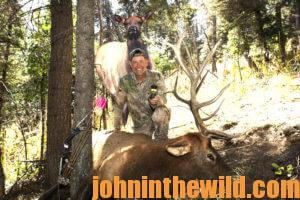
* Why Less Calling Is More – Another bull taught me a lesson I’ll never forget. I was hunting over a water hole in a tree stand with my recurve bow, I spotted a bull about 3/4-mile away from the water hole, and I made three loud cow calls. I saw that bull walk a zigzag pattern as it came to me, trying to find the cow that had called to him. He walked past my tree stand at 26 yards, and I shot him. We have that hunt on video also. So, that bull elk taught me that less is more when you’re hunting from a tree stand because, especially on public land, everyone likes to use their bugle calls and their cow calls. When an elk hunter buys an elk call, he or she likes to blow, and I’m the same way. I’ve learned that you’ll probably spook more bulls by calling too much than you will from calling very little. That elk was able to hear my call because I was using a Wayne Carlton Native Game Calls diaphragm (https://www.blackovis.com/brands/native-by-carlton), and I put it inside a Wayne Carlton tube, to make that cow call really reach out and touch that bull. The country I hunt and guide in is relatively open, and I’ve watched elk come from as much as a mile away before to a call.
I’ve confirmed what I learned about calling elk when I had a client hunting with me, and we were on top of a bridge. Down below us was another client and a guide hunting a patch of aspens. I heard my guide call, and I told my client, “That’s my guide Brian calling down into the aspens.” We looked way out in front of the patch of aspens and saw a bull get up and out of his bed and walk toward Brian and his client. I told my client, “Your buddy down there with Brian is about to smoke this elk.” We watched this bull walk about 150 yards straight 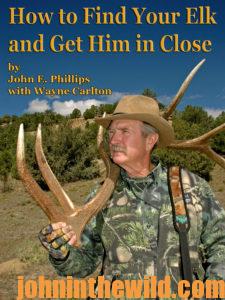 toward Brian and his hunter. I didn’t know it at the time, but Brian and my client’s buddy down in the aspens couldn’t see the bull coming. Then we heard Brian call again. We looked toward the bull, and he slowed way down and started stopping and hooking some brush. Once the bull went about 75 yards, we heard Brian call again. That bull stopped, turned completely around and went back to his bed. We knew for certain that the bull couldn’t smell or see the two hunters, but this hunt was on public lands. That bull knew because there was so much calling that more than likely that wasn’t a cow talking to him. What I learned from those two experiences was after I made three or four calls, I needed to sit still for 20-25 minutes before calling again, since there might be a bull I couldn’t see coming to me.
toward Brian and his hunter. I didn’t know it at the time, but Brian and my client’s buddy down in the aspens couldn’t see the bull coming. Then we heard Brian call again. We looked toward the bull, and he slowed way down and started stopping and hooking some brush. Once the bull went about 75 yards, we heard Brian call again. That bull stopped, turned completely around and went back to his bed. We knew for certain that the bull couldn’t smell or see the two hunters, but this hunt was on public lands. That bull knew because there was so much calling that more than likely that wasn’t a cow talking to him. What I learned from those two experiences was after I made three or four calls, I needed to sit still for 20-25 minutes before calling again, since there might be a bull I couldn’t see coming to me.
To learn more about hunting elk, check out John E. Phillips’ book, “How to Find Your Elk and Get Him in Close,” available in Kindle, print and Audible versions at http://amzn.to/17ENNqK.
Tomorrow: Fred Eichler Says the Elk’s Nose Determines Your Set-Up

